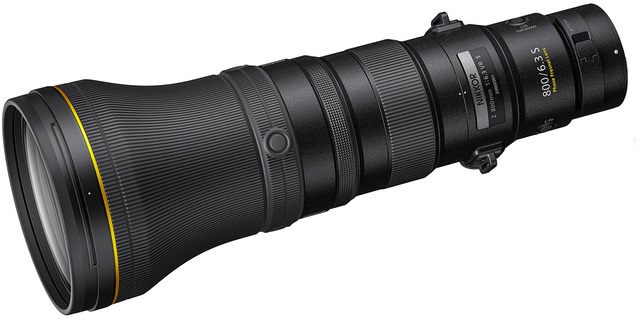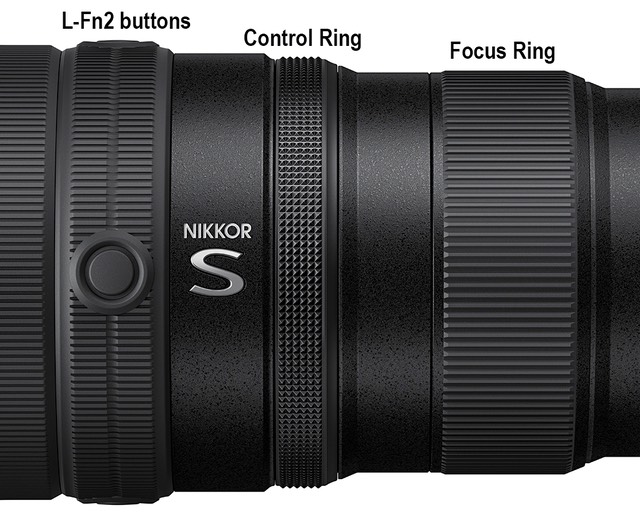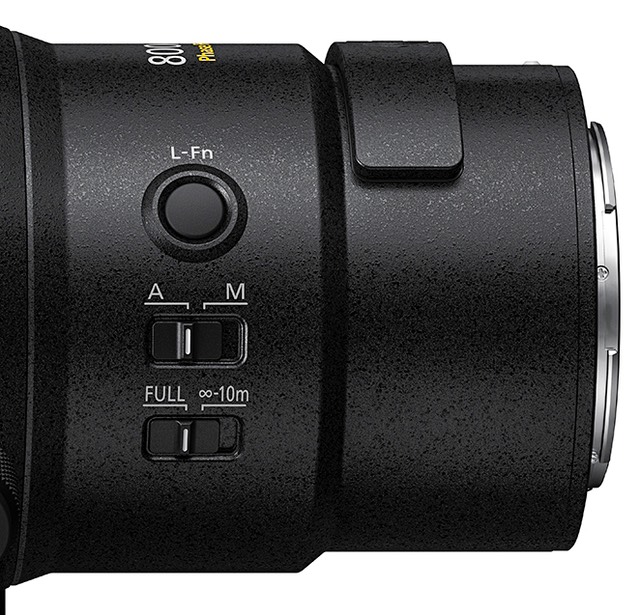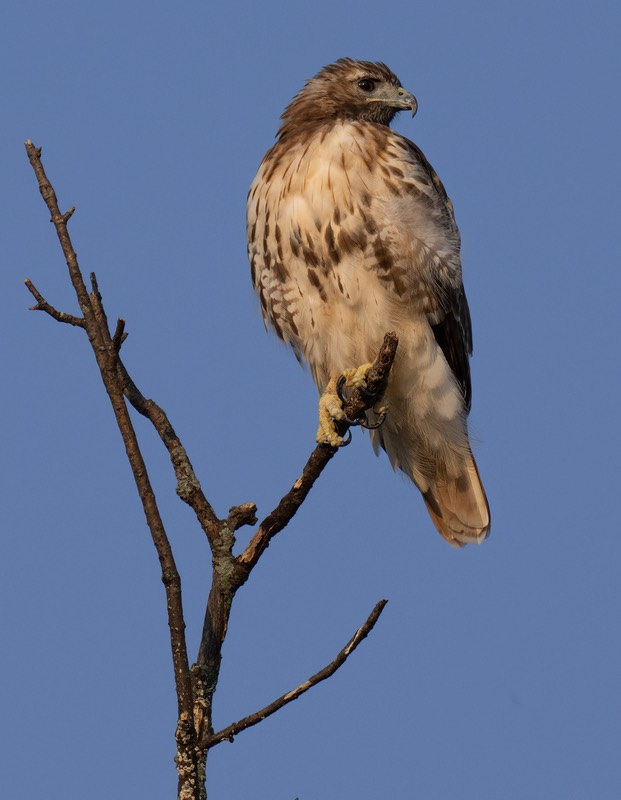
What is It?
I wasn’t planning on reviewing the 800mm f/6.3 PF VR S, as it was in very short supply and I don’t tend to use such a long focal length. Thus, I wasn’t going to buy one, and for the work I do, I wasn’t going to borrow one.
Until it became clear to me that seemingly every Z9 owner wanted a full and thorough description of every >200mm lens in the Z lineup, and wanted it now. So I decided I needed to get into the NPS Priority Purchase queue. When I told NikonUSA that I had placed an order, Nikon’s Vice President decided to prioritize my order. The next 800mm that came into the country came to me. Sorry about that for all of you still waiting in line. I’m a little surprised that Nikon’s still listening to and paying attention to me at the moment, but I thought it proper to disclose that Nikon did something for my benefit in getting me the lens.
When the 800mm lens first got added to the Road Map, it seemed pretty clear that it had to be a PF (phase fresnel) lens, as the size of the silhouette made it clear that it wasn’t going to be a repeat of the 800mm f/5.6E TC VR that we had in the F-mount.
Phase Fresnel is a Nikon technology (though others have different diffractive lens approaches), where one of the lens elements is a custom fresnel element. A PF element has a series of concentric circles with slightly different curvature instead of a single curvature on an element (asphericals use a complex continuous curvature). The use of such an irregular element has pluses and minuses.
First, using PF allows the optical design to be simpler, more compact, and overall lighter than a traditional telephoto lens design. The downside is that strong, slightly offset backlight can cause an unusual, wide ring flare. It’s generally recommended to avoid light sources in the frame (sun, lights, LED displays, etc.) with PF lenses, and even a strong, bright sky with a very underexposed foreground subject can produce reduced contrast.
In practice, though, the PF lenses Nikon has made (300mm f/4E and 500mm f/5.6E in the F-mount, this 800mm f/6.3 PF S VR in the Z-mount) have proven to be very useful and reliable wildlife and sports optics. It’s rare that I see conditions that might cause that flare to show itself (and Nikon NX Studio has a PF Flare Control option that can reduce its visual impact if it does show up).
Note: Nikon has limited equipment to produce PF elements. Rumor has it that there is only one PF polishing machine, which explains why the PF lenses all have such limited supply, at least initially.
Typically, you’d expect an 800mm lens to be something near 800mm in overall length given the Z-mount's close back distance. The 800mm f/6.3 PF VR S is only 386mm long (15.2”). It’s also a respectable 84.1 ounces (2385g). By comparison, the F-mount 800mm f/5.6E is 461mm long (plus add the mirror box) and 162 ounces (4590g). The Z-optic is much more travel friendly, and some even regard it as hand holdable. (Five+ pounds is a stretch for that; you won’t be able to hold that well for long sessions, and it’s difficult to keep that much mass centered on a fast moving subject.)
Despite the PF element, the optical chain in this lens is still pretty complex: 22 elements in 14 groups. Three of those are traditional Nikon ED glass, while one is the relatively new SR (short-wavelength refractive) design. The front element is fluorine coated to reject moisture and dust, while Nano coating is used on at least one of the internal elements to reduce flare tendencies.
3°10’ field of view (FX) is pretty small. One of the common issues with this much telephoto reach is finding and staying aligned with moving subjects. More static subjects—birds on stick, distant football linemen, etc.—are easily found and steadied, but birds in flight and running backs changing direction while coming at you are going to be something you have to train yourself to be able to follow well at 800mm.
I mentioned “steadied”. The 800mm f/6.3 PF VR S has in-lens stabilization that achieves 5 stops reduction in CIPA testing, and 5.5 in Synchro VR mode with the Z9 body. Like all recent Nikon VR systems, both Normal (which re-centers) and Sport (which supports panning) are available.
Maximum aperture is f/6.3, minimum is f/22, and as you stop down a nine-blade aperture diaphragm is used.
Closest focus is 16.4 feet (5m), which produces a 1:6.3 maximum magnification. That’s not particularly close, though it’s significantly less than the 800mm f/5.6E. You normally use an 800mm lens for distance work, but that comes with a caveat of its own: the atmospheric differences between you and your subject can produce some clear distortion and sharpness issues. I hesitate to call these “heat waves” because pretty much any surface/air temperature difference can start to have implications at long distances.
A lot of you want 800mm for “small birds.” The previous paragraph defines your use window. You can’t be too close (can’t focus), but you can’t be too far away because the air conditions can impede your results. Personally, I prefer a closer-in window of opportunity, which is why I like a closer focusing 400mm lens more and why I initially wasn’t going to acquire and use the 800mm lens being reviewed.
We have to talk about the build of the lens. And there’s a lot to talk about.
It’s S-line, so the lens is both weather and dust resistant. But that big 140mm front diameter means that you get a giant carbon fiber type lens hood (HB-104) with Nikon’s usual “sock” lens cap (LC-K106). Here’s the problem I have with that: while traveling with the lens in a bag (e.g. on an airline), leaving Nikon’s hood/cap solution on takes up far too much space in the bag (even the sock is huge), and you have to be careful that nothing is bumping against the sock while traveling. One of the LensCoat Hoodie or OP/TECH Hood Hat covers makes more sense, but I really would have liked something like the old AquaTech rubber lens caps custom fit to the lens, instead. The best cap solution at the moment is the Zemlin (US$85).
Another annoying aspect is the tripod handle. Nikon still hasn’t figured out that we all take off the supplied handle and replace it with one with an Arch-style plate. The Z-mount handles use different screw hole positions than most of the F-mount ones, so we’re now buying new plate/handles again. I’ve put a Wimberley one on my 800mm because it is the longest I’ve found to date, giving me more handle to grip, but lower cost Asian models seem to pop up all the time.
The 800mm uses Nikon’s 46mm drop-in filters. Nikon's circular polarizer is US$512 (gulp).
Other build-related bits include a Kensington-style lock, an L-Fn button, four L-Fn2 buttons, an additional control ring, a focus limiter switch (10m to infinity), and the usual A/M switch. You also get a nice CL-L3 case for carrying the lens.
Note: As I complete this review, the lens has been out for 8 months and is so popular and in such short supply that most Nikon subsidiaries aren’t currently taking orders for it. I know people who ordered the lens on the day it was announced who still haven’t received one. So the question for some becomes how do you get to 800mm if you can’t get this lens? My suggestion is the 400mm f/4.5 and the 2x teleconverter. This provides a very hand holdable 800mm, though it is f/9 maximum aperture. The results aren’t quite as good as the 800mm produces on its own, but still quite decent.
The 800mm f/6.3 PF VR S is made in China and sells for US$6499. The lens is weather sealed and comes with a full carrying case.
Source of the reviewed lens: NPS priority purchase that was further expedited by NikonUSA.
How's it Handle?
Once again we have control placement to talk about. The good news is that I usually want my hand under the lens (when hand holding) in a position that gives me reasonable access to the added control ring and the L-Fn2 button. Also, the Z9 now allows me to reprogram the DISP button on the camera, so I can “fit” most of my focus override options now into controls that I don’t have to reach for.

Still, it would have been nice if Nikon had thought through the control positions more rather than put them where it was easy for them in the engineering. The L-Fn button, for instance, is near the lens mount where you won’t be using it in the heat of action. I would have preferred the wider focus ring to be forward and the extra control ring to be forward of the L-Fn2 buttons (or behind the focus ring).

Even a few other reviewers have commented on my strong aversion to lens controls scattered around the lens. Here’s the problem, folks: when I put a different exotic lens (400mm, 600mm, 800mm, etc.) on my Z9, I have to remap the Custom Setting control assignments. But Nikon, in their infinite wisdom, only gives me one Save/Load settings option (no, I’m not going to use banks for this, as I need those for other things I need to switch quickly, particularly since Photo/Video banks are not separated). Thus, putting a different lens on my camera requires me to spend time reprogramming the camera. And then I have to adjust my hand and finger positions to what the lens allows.
As I’ve noted, the 100-400mm has the most usable set of lens controls, as you don’t have to shift hand positions to do a lot. The 400mm f/2.8 TC VR S is the worst. The 800mm f/6.3 VR S is somewhere in between. But again, if I move from one of those lenses to another, I’ll be sitting reprogramming Custom Setting #F2 controls on my Z9. This is pro? No. I’m going to beat this bush until the snake is killed.
I’ve already mentioned the hood/cap and tripod mount. That Nikon continues with their unfriendly designs here just shows how stubborn they are or that they’re not paying attention to those of us using the big lenses. The handle isn’t 100% hand friendly (how much depends upon your hand size). There’s no Arca-style plate. And in the case of the 800mm f/6.3 PF VR S, it takes an Allen wrench to remove.
It is nice that we get the strap mounts on the lens again, though that’s generally not the way I “hang” my long telephotos. I personally use a Blackrapid strap with an Arca conversion to tie to the Wimberley plate I use instead of Nikon’s foot, and then use the strap mount for my failsafe strap.
The center of gravity of the 800mm f/6.3 PF VR S is decidedly not far forward, which is good. The old exotics tended to be front-heavy. Nikon’s Z-mount exotics all are moving the weight back towards the mount, which is less fatiguing.
How's it Perform?
Focus: Surprisingly nimble. I’m tempted to say that the 800mm f/6.3 PF VR S is a little faster than the 400mm f/2.8 TC VR S, but it’s really difficult to make any meaningful fruit-to-fruit comparison, let alone apples-to-apples. Let’s just say that I was very pleased with the focus performance.
However, video users should be aware that the lens will focus breath. In a long focus pull, this will be clearly visible.

Perhaps to celebrate my 800mm arriving, no sooner had I unpacked it when I found this hawk sitting 100 feet away as I looked out my office window. I walked to the door and snapped it quickly, hand held. Other than a bit of a crop, enjoy my out-of-camera first image result.
Sharpness: Nikon's published MTF charts look essentially like flat lines, suggesting that this lens is near perfect optically. In practice, things are not quite so perfect. I found excellent acuity in the center wide open, with the edges bordering on the very good/excellent boundary. The lens actually improves slightly at f/8, putting it clearly at excellent center through edge capability, and very close to the outstanding capability of the 800mm f/5.6E TC VR. No doubt using this lens with its full or nearly full light gathering ability is where you want to be, as both diffraction and optics start clearly taking away performance past f/11 on the 45mp cameras.
That’s all at distance, but surprisingly I found the same traits at the closest focus distance, too.
Compared to the 400mm f/2.8 TC VR S with the 2x teleconverter: other than perhaps the center, the 800mm f/6.3 PF VR S wins, though perhaps not by as much as you'd expect. The 400+TC starts to show clear acuity loss outside the DX corners, and the extreme corners can have clear blur to them wide open. Not so the 800mm, which retains acuity well out to the corners, and extremely so at f/8. That said, the DX area with the 400mm+TC looks astonishing good for 2x teleconverter use when stopped down one stop. Still doesn't quite match the 800mm f/6.3 PF VR S, but I find the 400mm+TC combination extremely usable.
800mm with the 1.4x teleconverter (1120mm f/9): surprisingly good. I'd judge the center through corners to all be in the very good range (note though that everything is clearly down in acuity from the lens without a teleconverter). I'm not sure I've seen this level of performance from any optic at above 1000mm other than perhaps the 800mm f/5.6E TC VR with it’s 1.25x converter in place. Stopping down doesn't tend to help corners due to diffraction impacts coupled with some slight field curvature introduced by the teleconverter, but it does help the center slightly.
Coma is well controlled, as are spherical aberrations. Field curvature was mostly not seen in my testing. I did see a very minor curve at the closest focus distance, but that all but disappears at f/8. I also saw some minimal curvature with the teleconverter.
All of the above was suggested by Nikon's "flat" MTF charts. Someone dialed in the optical formula really, really well. This lens is about as good as I've ever seen at 800mm (or equivalent). Moreover, at the US$6500 price, I don’t know of another 800mm option that comes even reasonably close.
The lens does have some focus shift (to the back), so be careful using it at any aperture beyond the maximum, as the Z System autofocus system won't automatically correct for it.
Vignetting: Surprisingly low, with about a stop of vignetting wide open, though it has a broad range that begins within the DX boundary. By f/11 vignetting is completely ignorable, even without the lens corrections.
Linear Distortion: evident pincushion distortion, just above 1%, which is a level I'd tend to correct for if any straight lines are present in the image, but not otherwise (e.g. wildlife work).
Chromatic Aberration: Lateral CA is below one pixel width on the 45mp bodies, so basically ignorable. Longitudinal CA is not really present wide open, though appearing only in very low levels I would consider ignorable.
Bokeh: The only real fault is cats eye and clipping of the out of focus highlights as you move out towards the corners. This starts to show up near the DX crop, and is quite evident in the FX corners. Beyond that, there's a very slight bright edge on highlights out of focus, but no visible coloration and surprisingly no visible onion skinning of the blur. I'd expect out of focus backgrounds to look very smooth, though bright highlights will reflect that cats eye problem in the corners.
As with all PF lenses, be aware that in-frame backlighting can cause a soft but clear flare around and near the light source.
Final Words
So, here's a lens with great optics, an S level build and features, in a lighter and smaller 800mm package than you're probably used to, and at a price not that much more than a top camera body. You're going to buy it, right? ;~)
As I noted up front, I thought long and hard about the 800mm f/6.3 PF VR S when it came out, and I also debated its viability with a number of pros. What would I actually use 800mm (or more with a teleconverter) for? The two answers that kept coming up were sports with sometimes very remote photo positions (e.g. soccer, lacrosse, surfing) and small birds at reasonable distance. One problem with 800mm is that the perspective then also becomes from a distance, which gets a little boring in repeated use. Plus distance has this tendency to introduce heat waves between you and the subject, rendering the resulting image not so nice, and sometimes unfixable.
I already own multiple ways to get to 500-560mm, which is about the maximum focal length I tend to use. Even with 500mm used at subject-fills-frame distances heat waves can be an issue mid-day on sports fields and out in the savannah. Thus my initial reluctance to get the 800mm f/6.3 PF VR S.
The thing driving many amateurs is POS (pixels on subject) when they don't have excellent subject access. 800mm gives you more POS, for sure. But in looking at some of the early results from amateurs with the lens, I saw a lot of cropping of high megapixel cameras with the 800mm to get their final results, which means that they're just not close enough to their subject for my taste. If this describes you, then, sure, the 800mm f/6.3 PF VR S is probably a lens that will interest you, as you'd crop even more with a 500mm. However, be prepared for dealing with two significant issues with this lens: (1) keeping 800mm framed on a subject that fills the frame and is moving (birds in flight that are closer to you); and (2) those pesky heat waves that can occur between you and your subject.
I've watched the Coolpix P1000 folk with their 3000mm equivalent lenses get some interesting and excellent photos—mostly of small static subjects—so there's something to be said for pixels on subject. The question you have to answer for yourself is whether US$6500 coupled with those minor issues I note above is really the right cost/benefit choice. I can't answer that for you. What I can say is that while I decided to pass on purchasing the 800mm initially, I’m mostly glad I changed my mind, even though it isn’t a lens that’s getting as much use as my other long lenses. Given the price and the limited availability, you might consider renting one when you need it.
In terms of results when heat waves aren’t a factor, the 800mm f/6.3 PF VR S is a really sharp lens capable of pulling those more distant subjects onto more pixels on your camera. I’m a little scared to take it to Africa, as then I’ll probably be juggling three cameras and lenses (70-200mm f/2.8 VR S, 400mm f/2.8 TC VR S, and 800mm f/6.3 PF VR S, eek).
Thus, my final recommendation should be obvious: I can wholeheartedly recommend the lens, if it's really the lens you need, a lens you will use regularly, and you can deal with the longer subject distances you're likely going to be using.
Highly Recommended (2022 to present)
Support this site by purchasing from the following advertiser:
